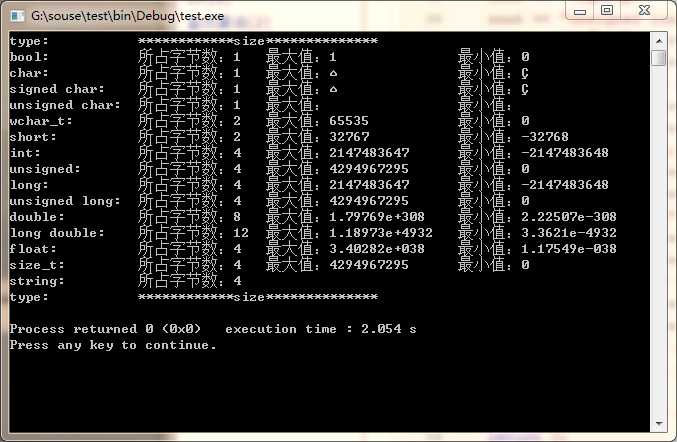1 #include<iostream> 2 #include<string> 3 #include <limits> 4 using namespace std; 5 6 int main() 7 { 8 cout << "type: \t\t" << "************size**************"<< endl; 9 cout << "bool: \t\t" << "所占字节数:" << sizeof(bool); 10 cout << "\t最大值:" << (numeric_limits<bool>::max)(); 11 cout << "\t\t最小值:" << (numeric_limits<bool>::min)() << endl; 12 cout << "char: \t\t" << "所占字节数:" << sizeof(char); 13 cout << "\t最大值:" << (numeric_limits<char>::max)(); 14 cout << "\t\t最小值:" << (numeric_limits<char>::min)() << endl; 15 cout << "signed char: \t" << "所占字节数:" << sizeof(signed char); 16 cout << "\t最大值:" << (numeric_limits<signed char>::max)(); 17 cout << "\t\t最小值:" << (numeric_limits<signed char>::min)() << endl; 18 cout << "unsigned char: \t" << "所占字节数:" << sizeof(unsigned char); 19 cout << "\t最大值:" << (numeric_limits<unsigned char>::max)(); 20 cout << "\t\t最小值:" << (numeric_limits<unsigned char>::min)() << endl; 21 cout << "wchar_t: \t" << "所占字节数:" << sizeof(wchar_t); 22 cout << "\t最大值:" << (numeric_limits<wchar_t>::max)(); 23 cout << "\t\t最小值:" << (numeric_limits<wchar_t>::min)() << endl; 24 cout << "short: \t\t" << "所占字节数:" << sizeof(short); 25 cout << "\t最大值:" << (numeric_limits<short>::max)(); 26 cout << "\t\t最小值:" << (numeric_limits<short>::min)() << endl; 27 cout << "int: \t\t" << "所占字节数:" << sizeof(int); 28 cout << "\t最大值:" << (numeric_limits<int>::max)(); 29 cout << "\t最小值:" << (numeric_limits<int>::min)() << endl; 30 cout << "unsigned: \t" << "所占字节数:" << sizeof(unsigned); 31 cout << "\t最大值:" << (numeric_limits<unsigned>::max)(); 32 cout << "\t最小值:" << (numeric_limits<unsigned>::min)() << endl; 33 cout << "long: \t\t" << "所占字节数:" << sizeof(long); 34 cout << "\t最大值:" << (numeric_limits<long>::max)(); 35 cout << "\t最小值:" << (numeric_limits<long>::min)() << endl; 36 cout << "unsigned long: \t" << "所占字节数:" << sizeof(unsigned long); 37 cout << "\t最大值:" << (numeric_limits<unsigned long>::max)(); 38 cout << "\t最小值:" << (numeric_limits<unsigned long>::min)() << endl; 39 cout << "double: \t" << "所占字节数:" << sizeof(double); 40 cout << "\t最大值:" << (numeric_limits<double>::max)(); 41 cout << "\t最小值:" << (numeric_limits<double>::min)() << endl; 42 cout << "long double: \t" << "所占字节数:" << sizeof(long double); 43 cout << "\t最大值:" << (numeric_limits<long double>::max)(); 44 cout << "\t最小值:" << (numeric_limits<long double>::min)() << endl; 45 cout << "float: \t\t" << "所占字节数:" << sizeof(float); 46 cout << "\t最大值:" << (numeric_limits<float>::max)(); 47 cout << "\t最小值:" << (numeric_limits<float>::min)() << endl; 48 cout << "size_t: \t" << "所占字节数:" << sizeof(size_t); 49 cout << "\t最大值:" << (numeric_limits<size_t>::max)(); 50 cout << "\t最小值:" << (numeric_limits<size_t>::min)() << endl; 51 cout << "string: \t" << "所占字节数:" << sizeof(string) << endl; 52 // << "\t最大值:" << (numeric_limits<string>::max)() << "\t最小值:" << (numeric_limits<string>::min)() << endl; 53 cout << "type: \t\t" << "************size**************"<< endl; 54 return 0; 55 }

以上结果已经很明白了,一下补充说明几点:
概念、整型:表示整数、字符和布尔值的算术类型合称为整型(integral type)。
关于带符号与无符号类型:整型 int、stort 和 long 都默认为带符号型。要获得无符号型则必须制定该类型为unsigned,比如unsigned long。unsigned int类型可以简写为unsigned,也就是说,unsigned后不加其他类型说明符就意味着是unsigned int。
一字节表示八位,即:1byte = 8 bit;
int: 4byte = 32 bit 有符号signed范围:2^31-1 ~ -2^31即:2147483647 ~ -2147483648无符号unsigned范围:2^32-1 ~ 0即:4294967295 ~ 0
long: 4 byte = 32 bit 同int型
double: 8 byte = 64 bit 范围:1.79769e+308 ~ 2.22507e-308
long double: 12 byte = 96 bit 范围: 1.18973e+4932 ~ 3.3621e-4932
float: 4 byte = 32 bit 范围: 3.40282e+038 ~ 1.17549e-038
int、unsigned、long、unsigned long 、double的数量级最大都只能表示为10亿,即它们表示十进制的位数不超过10个,即可以保存所有9位整数。而short只是能表示5位;
另外对于浮点说而言:使用double类型基本上不会有错。在float类型中隐式的精度损失是不能忽视的,二双精度计算的代价相对于单精度可以忽略。事实上,在有些机器上,double类型比float类型的计算要快得多。float型只能保证6位有效数字,而double型至少可以保证15位有效数字(小数点后的数位),long double型提供的精度通常没有必要,而且还要承担额外的运行代价。
double是8字节共64位,其中小数位占52位,2-^52=2.2204460492503130808472633361816e-16,量级为10^-16,故能够保证2^-15的所有精度。
在有些机器上,用long类型进行计算所付出的运行时代价远远高于用int类型进行同样计算的代价,所以算则类型前要先了解程序的细节并且比较long类型与int类型的实际运行时性能代价。
转自:http://blog.csdn.net/xuexiacm/article/details/8122267



C/C++中各种类型int、long、double、char表示范围(最大最小值)(转)
原文:http://www.cnblogs.com/yoyo-sincerely/p/5204053.html